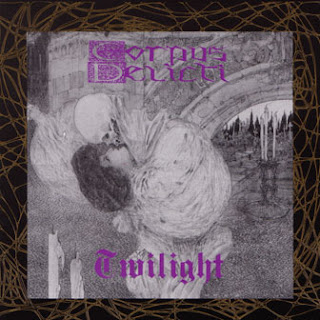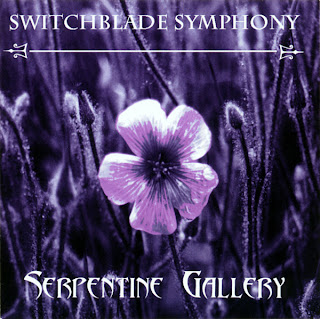I know – I do give 90’s Goth a lot of shtick.
I won’t name and shame, (the litany of the bands I detest from the period would make for a blog in itself) but really…much of it was just...well…awful.
That said however, is not to say that there weren’t some redeeming features, and some bands did it really well, and sometimes even intelligently.
I’m not going to analyse this in depth, but just to get it off my chest, what we have here is an inexhaustive sample of material from 90’s Goth that offended me least.
To all intents and purposes, the band that launched the second wave. I’ve often wondered what might have wandered through the mind of journalist Mick Mercer when these kids burst out after he wrote that “Fresh impetus into the Gothy scene seems unlikely” (The Gothic Rock Black Book, Omnibus Press, 1988). Probably very little, since he declared the Goth scene dead for a second time writing in Gothic Rock (Pegasus, 1991) with “This book is all but done. I can’t see me doing another on the topic, unless Goth is due for an entire rebirth which seems totally unlikely”. Seemingly unapologetic, the Mighty Mick has since gone on to produce at least another three volumes on said topic.
Hot on the heels of Rosetta Stone came The Screaming Marionettes, who would soon shorten their name somewhat. Although it’s probably safe to say The Marionettes represented a case of the anthemic over the cerebral, the title track of their debut album (Ave Dementia, Flicknife Records, 1991) remains a Goth dance-floor classic. Oddly enough, it doesn’t ever seem to have been released as a single. The Marionettes went on to release at least another three albums. Not seeming to take themselves completely seriously probably worked in their favour.
The third big name in the second wave.
It’s probably easier if I just confess up front to having always been uneasy with Nosferatu. Riding around in an antique hearse, and taking the vampire imagery beyond either the metaphorical or the tongue-in-cheek of “
Bela Lugosi is Dead” to the literal level never struck me as something resembling a serious musical project so much as a tribute to The Munsters. The harpsichord intro to “
Vampyre’s Cry”, a complete rip-off of
The Sisters “
Black Planet” didn’t help either. Indeed, it’s so close, that I’ve often wondered if it really was plagiarism or simply Nosferatu’s ill-advised attempt at humour.
Nevertheless, just as if you sit enough monkeys at typewriters, one of them will eventually replicate The Complete Works of Shakespere, even Nosferatu managed to get it right once in a while. This is from the B-Side of the Diva single (Possession Records, 1992).
Charging out of Hasting, and certainly one of the better generic bands, these are from their album Tourniquets of Loves Desire (Cleopatra, 1994). They also get bonus points for taking their name from a March Violets song. The album cover was certainly effective, if simple, with a specialist Goth record shop and label in
Melbourne seemingly taking a variant of it as their logo. Unfortunately, if we fast-forward a few years, we find Children on Stun releasing an album entitled Mondo Weird (M and A Musicart, 1997) which must have seemed like a good idea at the time, and even worse was to come the following year with Outrageous, Outlawed, Outspoken (M and A Musicart, 1998), a title that sounds more like something that might emanate from the bowels of some hellish 80's hair metal band than anything remotely to do with Goth.
Vastly more compelling than other many French Acts like say, Lucie Cries, Corpus Delecti swiftly rose to much-deserved prominence, for once escaping the cookie-cutter sound of so many
Sisters clones, often with instrumentation more resembling
Bauhaus. Even if the imagery was often over the top, it was a welcome change nevertheless. Absent Friend comes from their first album Twilight (Glasnost, 1993) and Saraband and Noxious from the Sylphs album (Glasnost, 1994). If you wanted to investigate deeper, then the Sarabands compilation (Cleopatra, 1996) comes highly recommended.
Another French band. When on the money, they did it much better than a legion of others. Forgiving them for calling their debut Tales of Vampires (Darkland of Tears, 1995) was considerably more difficult, but songs like "Resurrection" certainly helped.
And so we shift our attention to the
US. Just as The UK scene had been swept up in the wake of
The Sisters and The Fields of the Nephilim and moved away from their original post-punk origins, so too did the
US scene become dragged away from its origins in Death Rock.
Switchblade Symphony neatly managed to rise above the rest of the pack though with a heavy synth wash and an often orchestral and laid-back approach that rendered Serpentine Gallery (Cleopatra, 1995) one of the shining jewels in the crown of second wave Goth.
Another
US offering here. I must admit to not having particularly liked their eponymous debut album (Cleopatra,1993) which probably explains why it’s been years since I listened to it. “
Eleven Eleven” was a good track however, and managed to make its way onto Cleopatra Records’ very dubious re-release of The Whip compilation (1993). Better still though was “
Kristen”, which despite labouring under the now aged Goth cliché of the girl’s-name song, I thought quite exemplary for Goth from this period.
Although their first album Selected Scenes from the End of the World (Apocalyptic Vision, 1995) occasionally verged into abject silliness, its earlier incarnation as a demo tape reportedly sold thousands of copies. Their second full length Psycho Magnet (Apocalyptic Vision, 1996) was a much stronger beast and marks them as one of the last great Goth bands before everything went all dance oriented.
Absolutely nothing to do with the solo project of Motley Crue’s Nikki Sixx.
This little known US band were in fact a side project of influential black metal outfit Von, and to be fair, was almost certainly a cash-in attempt at Goth during a time when black metal was virtually unknown outside of Scandinavia.
Although far from being musically original, Sixx nevertheless managed to deliver something genuinely atmospheric in the occult vein without falling into the trap that caught so many bands like Nosferatu or Two Witches who all too often came off resembling a cheesy Hammer Horror fest.
Although Sixx never formally released any recorded material, the band remastered their 1991 demo Sister Devil on Nuclear War Now Productions in 2010.
These kids I admit to having discovered retrospectively. Somehow they completely slipped under the radar at the time I was still DJing and on hearing “Marilyn (My Bitterness)” at a Der Kellar night in Perth sometime around 2003 found myself in the slightly embarrassing position of having to ask the DJ (a guy who I knew had grown up through the scene listening to the stuff I used to spin) what it was. Worse still, I had to sing an approximation of the song to him – I remain astounded he was able to work out what on Earth I was on about.
Cruxshadows had some unfortunate tendencies towards horribly pretentious lyrics and album titles, but this song I felt was exceptional, and also made for a nice demarcation between the very rock oriented second wave and the very dancy third. “Marilyn (My Bitterness)” is taken from their second album, Telemetry of a Fallen Angel (Nesak International, 1996)
For my money, they were absolutely the best Australian Goth offering from the second wave. Bands like Ikon and Subterfuge are worth checking out too, but BEC did it better, their demo “Susperia” making huge waves at the time it was released and their debut album Dreams of a Mad King (Cleopatra, 1994) even more so.
Like any good performer, we leave the best till last and end with a bang.
Germany’s
Syria (largely a one-man project of Mr Christian Dorge) quite clearly worshipped the ground
The Sisters of Mercy walked away from, and weren’t afraid to openly wear their hearts on their sleeves. All the signs were there, from their album art, the songs they chose to cover (brilliant versions of "
Giving Ground" by The Sisterhood and
The Sister's "
Under the Gun" exist), and references in their songs to earlier Sisters material.
What set Syria apart from the rest of the 90’s Goth horde however, is that rather than slavishly copying, Christian Dorge ran with
The Sisters’ post Vision Thing (Merciful Release, 1990) legacy and logically developed it to the place where The Sister’s should have gone instead of the mire in which
Andrew Eldrich has floundered for the last 20 or so years. Ozymadias Of Egypt (Black October Records, 1993) remains a criminally under rated album of Goth’s second wave – if only
Andrew Elritch was listening…
I know, I do diss 90's Goth a lot in retrospect, but to be fair,
photographic evidence suggests that at the time I might have been quite into it:
Your humble author (circa '94) - doing his
best to show exactly how not into it he was.

















